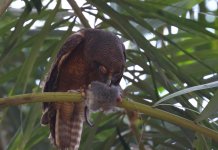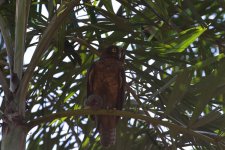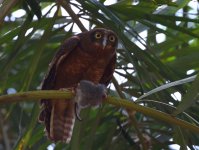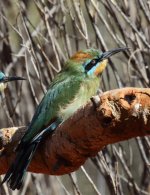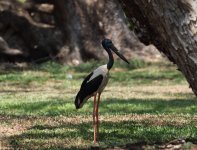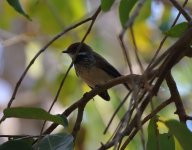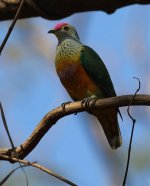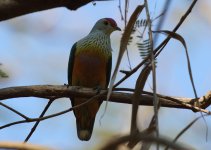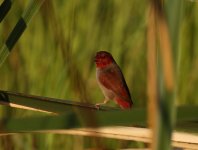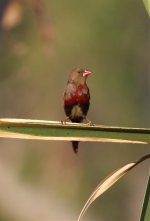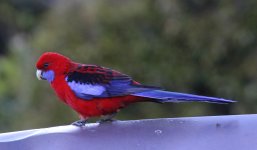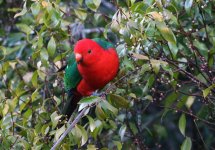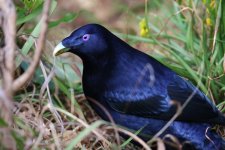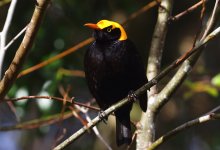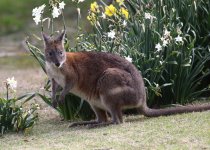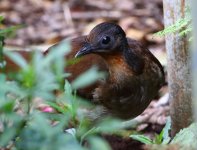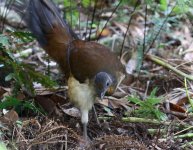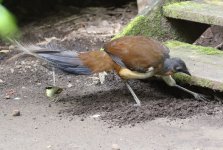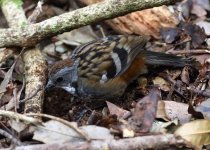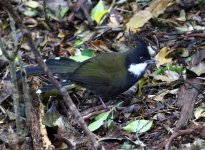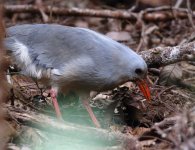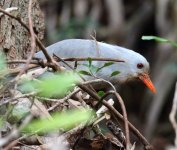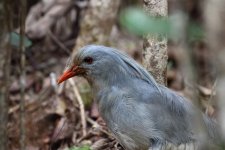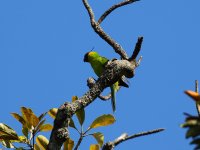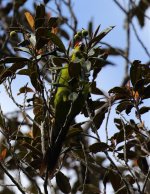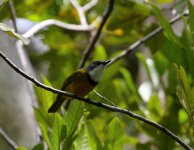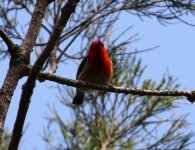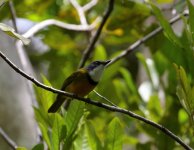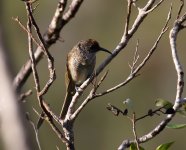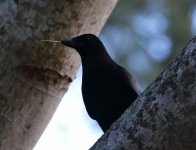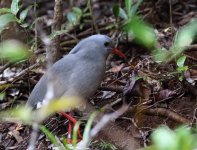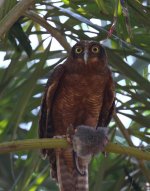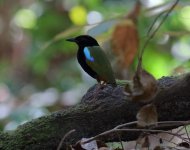dandsblair
David and Sarah
Darwin – Botanic Garden and Museum area
Darwin – Botanic Garden and Museum area
Today was originally going to be a day with John Rawstone a birding pal from Darwin but he is an AFL referee and had to referee an away game yesterday and would be out of town all day, he had though given us some advice and changed his schedule so he could go out with us tomorrow morning even though it is a working day for him.
He told us that the Rufous Owl was nesting near the rainforest loop in a large fig tree hole, with at least one chick in the nest and one of the adults was usually to be found in the tree nearby, so that was where we were heading after giving the car back. On the walk up to the gardens we passed a golf course and a bit of the gardens called bird-song gully, we saw Rainbow Bee-eaters, Masked Plover and Grey Goshawk before the gardens, Blue-faced Honeyeaters, Black Kites, Pied Imperial Pigeon and White Ibis in the main area before we got to the rainforest loop and on the pond Black-necked Stork, Radjah Shelduck and Grey Teal.
Our strategy was to look for a likely nest hole in every fig tree, there were a few including some figs that didn’t look like a traditional fig – after an hour without success we split up – about 20 minutes later a family asked me “would you describe yourself as a medium height Scottish gentleman”, I said I suppose so, they said “well a lady over the other side of those trees is looking for you”. I did wonder why Sarah hadn’t just said a guy with a large camera and binoculars – anyway I ran back and Sarah had seen the Owl, it was partly hidden and just when she got me on it the bird flew. I thought to a different perch in the trees below the path but at least I had seen roughly where it had gone and a Sulphur Crested Cockatoo with an alarm call helped narrow it down further, the Rufous Owl was sitting there holding a possum which he had just taken and was delicately removing the fur, presumably to feed the chick.
We had the pleasure of watching the bird for an hour and showed a few other birders it but it showed no sign of taking the prey to the nest, so we never did validate the nest hole.
I asked one of the local guides what type of possum it was but she said it was a rat, later they admitted they always say this to spare the visitors on their guided tours any distress.
We did have a look at the possible roost for Barking Owl but we think these were scared off just a day or so ago as an employee said there was quite a disturbance under the tree where the owls had been.
We then walked along the coast to the museum and the boardwalk and small lake beyond it. The museum was interesting particularly the stuff on the 1974 Cyclone that completely wrecked Darwin and we did manage a few birds including a Mangrove Robin, that responded immediately to a my call, on the little boardwalk, John was really surprised that a bird was here but thought that probably no one had tried for it in these Mangroves and hence it responded better than birds a mile or two along the coast at East Point. We also added Forest Kingfisher, Silver Gull, Varied Lorikeet, Bar-shouldered Dove and Rainbow Lorikeet (this Northern species is split by some as Red-collared Lorikeet).
Darwin – Botanic Garden and Museum area
Today was originally going to be a day with John Rawstone a birding pal from Darwin but he is an AFL referee and had to referee an away game yesterday and would be out of town all day, he had though given us some advice and changed his schedule so he could go out with us tomorrow morning even though it is a working day for him.
He told us that the Rufous Owl was nesting near the rainforest loop in a large fig tree hole, with at least one chick in the nest and one of the adults was usually to be found in the tree nearby, so that was where we were heading after giving the car back. On the walk up to the gardens we passed a golf course and a bit of the gardens called bird-song gully, we saw Rainbow Bee-eaters, Masked Plover and Grey Goshawk before the gardens, Blue-faced Honeyeaters, Black Kites, Pied Imperial Pigeon and White Ibis in the main area before we got to the rainforest loop and on the pond Black-necked Stork, Radjah Shelduck and Grey Teal.
Our strategy was to look for a likely nest hole in every fig tree, there were a few including some figs that didn’t look like a traditional fig – after an hour without success we split up – about 20 minutes later a family asked me “would you describe yourself as a medium height Scottish gentleman”, I said I suppose so, they said “well a lady over the other side of those trees is looking for you”. I did wonder why Sarah hadn’t just said a guy with a large camera and binoculars – anyway I ran back and Sarah had seen the Owl, it was partly hidden and just when she got me on it the bird flew. I thought to a different perch in the trees below the path but at least I had seen roughly where it had gone and a Sulphur Crested Cockatoo with an alarm call helped narrow it down further, the Rufous Owl was sitting there holding a possum which he had just taken and was delicately removing the fur, presumably to feed the chick.
We had the pleasure of watching the bird for an hour and showed a few other birders it but it showed no sign of taking the prey to the nest, so we never did validate the nest hole.
I asked one of the local guides what type of possum it was but she said it was a rat, later they admitted they always say this to spare the visitors on their guided tours any distress.
We did have a look at the possible roost for Barking Owl but we think these were scared off just a day or so ago as an employee said there was quite a disturbance under the tree where the owls had been.
We then walked along the coast to the museum and the boardwalk and small lake beyond it. The museum was interesting particularly the stuff on the 1974 Cyclone that completely wrecked Darwin and we did manage a few birds including a Mangrove Robin, that responded immediately to a my call, on the little boardwalk, John was really surprised that a bird was here but thought that probably no one had tried for it in these Mangroves and hence it responded better than birds a mile or two along the coast at East Point. We also added Forest Kingfisher, Silver Gull, Varied Lorikeet, Bar-shouldered Dove and Rainbow Lorikeet (this Northern species is split by some as Red-collared Lorikeet).




